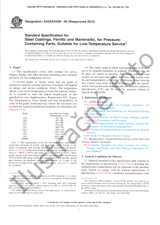Potrebujeme váš súhlas na využitie jednotlivých dát, aby sa vám okrem iného mohli ukazovať informácie týkajúce sa vašich záujmov. Súhlas udelíte kliknutím na tlačidlo „OK“.
ASTM D7486-22
Standard Test Method for Measurement of Fines and Dust Particles on Plastic Pellets by Wet Analysis
NORMA vydaná dňa 1.11.2022
Informácie o norme:
Označenie normy: ASTM D7486-22
Dátum vydania normy: 1.11.2022
Kód tovaru: NS-1096678
Počet strán: 5
Približná hmotnosť: 15 g (0.03 libier)
Krajina: Americká technická norma
Kategória: Technické normy ASTM
Kategórie - podobné normy:
Anotácia textu normy ASTM D7486-22 :
Keywords:
dust particles, fines, plastics, wet analysis,, ICS Number Code 83.140.99 (Other rubber and plastic products)
Doplňujúce informácie
| Significance and Use | ||||||||
|
5.1?Molding and extruding plastic pellets require dust free, dry pellets to prevent processing problems. Plastic producers try to remove the dust and streamers with dust removal systems prior to packaging and loading. How to accurately measure dust and streamer content in plastic pellets is an important quality control issue. 5.2?Particle size analysis is used to determine a percentage of particle size distribution from a representative sample of the whole. In terms of size analysis concerning plastic pellets, sieving is used to determine the dust content in the range of 500 to 2000 micron. Test Method D1921, Test Method B, is used to determine this type of particle sizing. 5.3?After dry sieve analysis, particles smaller than 500 microns need to be analyzed by wet method. A fresh sample shall be used for wet analysis. This test method allows washing down the fines attached to the pellets by electrostatic forces. 5.4?The wet analysis provides accurate quantification of small to large amounts of fines, negating static effects, and eliminating detrimental effects of mechanical agitation. A wet analysis must be employed to accurately quantify lower PPM dust levels in plastic pellets. |
||||||||
| 1. Scope | ||||||||
|
1.1?This test method measures the amount of fine particles adhered on plastic pellets or granules in which they are commonly produced and supplied. The lower limit of this test method is restricted only by the porosity of the filter disc used to capture the particle size being quantified. 1.2?The wet analysis technique allows for separation and collection of statically charged particles by liquid wash and filtration methods. This must be performed under standard laboratory conditions. 1.3?The values stated in SI units are to be regarded as standard. 1.4?This test method describes an essential practice to check the quality of plastics once the production cycle is terminated and to evaluate the performance of pellet cleaning systems or of the special pneumatic conveying systems for the distinct size fractions below 500 micron only. 1.5?This standard does not purport to address all of the safety concerns, if any, associated with its use. It is the responsibility of the user of this standard to establish appropriate safety, health, and environmental practices and determine the applicability of regulatory limitations prior to use. Note 1:?There is no known ISO equivalent to this
standard.
1.6?This international standard was developed in accordance with internationally recognized principles on standardization established in the Decision on Principles for the Development of International Standards, Guides and Recommendations issued by the World Trade Organization Technical Barriers to Trade (TBT) Committee. |
||||||||
| 2. Referenced Documents | ||||||||
|
Odporúčame:
Aktualizácia technických noriem
Chcete mať istotu, že používate len platné technické normy?
Ponúkame Vám riešenie, ktoré Vám zaistí mesačný prehľad o aktuálnosti noriem, ktoré používate.
Chcete vedieť viac informácií ? Pozrite sa na túto stránku.




 Cookies
Cookies
